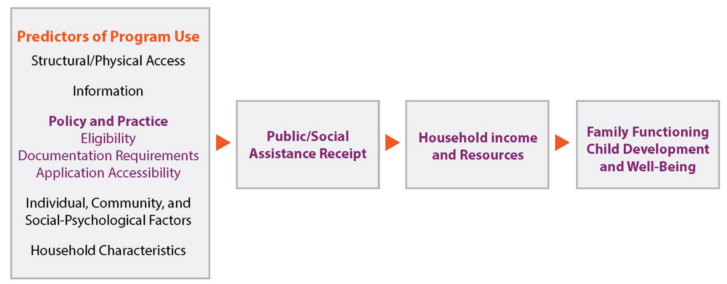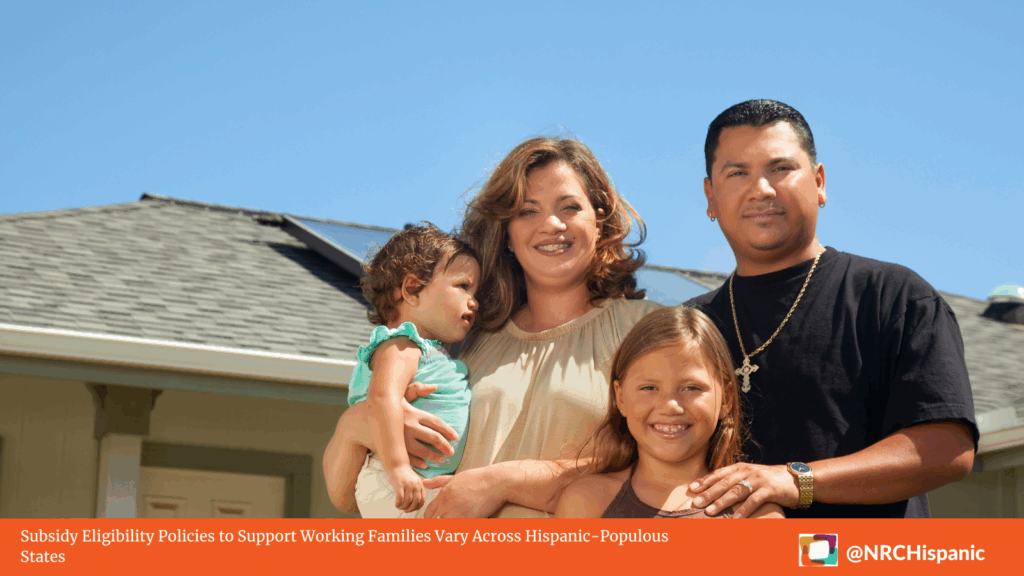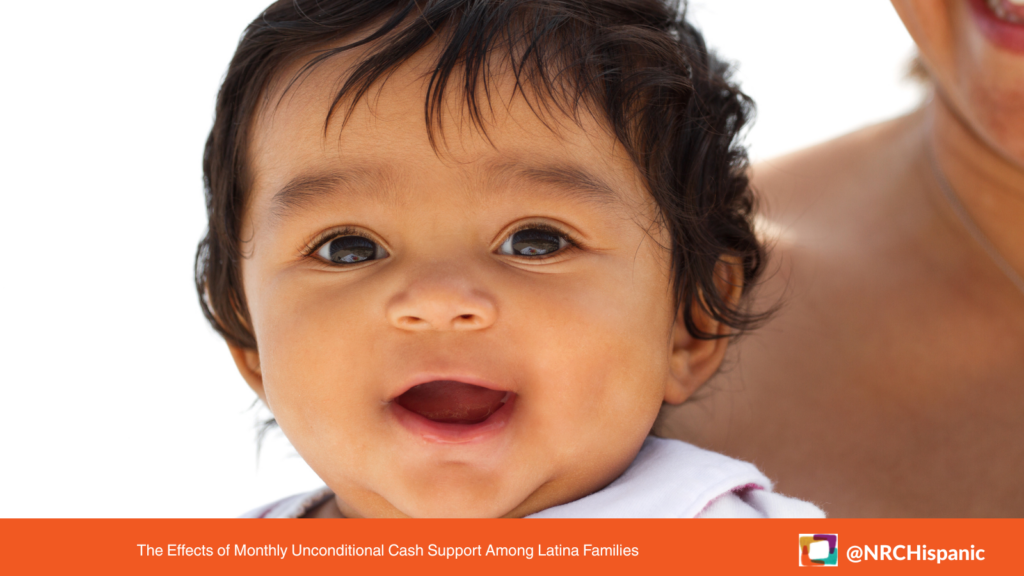Mar 20, 2025
Research Publication
Highlights From a Decade of the Center’s Research on Supports for Economic Self-sufficiency Among Latino Families With Children
Author:
Government economic support policies can harness Latino families’ strengths of labor market attachment and earnings to foster economic security and children’s well-being. This piece is an update to an earlier summary of key findings from the first five years of the Center.
Since 2013, the investigators and collaborators of the National Research Center on Hispanic Children & Families (the Center) have produced research that describes the demographic characteristics of Latino families in households with low incomes, along with their strengths, their economic well-being, and their access to government program benefits that can support them.
The Administration for Children and Families (ACF) within the U.S. Department of Health and Human Services, which funds the Center, is charged with promoting the economic and social well-being of children and families. In fiscal year 2024, nearly one quarter of ACF’s $70 billion budget was allocated to the Temporary Assistance to Needy Families (TANF) program, representing the largest allocation of fiscal dollars among ACF programs. The remaining three quarters of ACF’s budget was allocated toward dozens of complementary programs that support the economic and social well-being of children, families, and communities. Because many beneficiaries of ACF’s (and other federal agencies’) programs are Latinoa families and children, the Center’s priority has been to identify the ways in which policy, particularly ACF programs, may best support Latino families’ economic self-sufficiency and mobility and family well-being.
This piece draws on the Center’s work from 2013 to 2024 in the areas of poverty and economic self-sufficiency—along with companion publications on similar topics from Center scholars and motivated by the Center’s work—to offer three summative highlights of this research, including considerations for policymaking.
1. Understanding Latino demographic and geographic growth is a critical factor for supporting the economic well-being and security of Latino families and their children, as well as our nation’s future economic well-being.
The size and varied characteristics of the U.S. Latino child population
- Latino children and youth currently represent one quarter of the U.S. population under age 18 and are projected to be the fastest-growing population of young people in the United States through 2060. These population shifts indicate that the impacts of social policies and programs will be increasingly significant for Latino young people’s economic well-being. And, further, it will be difficult to meet policy goals such as reducing child poverty or improving 21st-century workplace readiness without accounting for Latino children and families.
- More than 9 out of 10 Latino children are U.S.-born and the majority of Latino children reside with two-parents and many live in multi-generational households. One quarter of Latino children have a parent or reside with an adult who is an unauthorized immigrant.b These demographic facts present both opportunities and challenges for Latino families with children. On the one hand, support and resources available in two-parent and multi-generational households may benefit Latino children, particularly when parents are juggling work and parenting. On the other hand, because eligibility criteria for public assistance programs vary based on who resides in households, relationships between household members and the child, and household members’ citizenship status, Latino families may also face different challenges than their peers when it comes to understanding what programs they are eligible for and the level of program benefits that they can receive, if any.
- Latino parents’ literacy (whether in English and/or Spanish), general English proficiency, and educational attainment can impact their employment options, ease of understanding and accessing government benefit programs, and the value of English as a Second Language programs as a component of employment-related training.
- Over half of Latino children are bi- or multi-lingual with proficiency in Spanish and English, a literacy and linguistic strength shown to positively influence future economic security.
Latino geographic growth
- The majority of Latino families with children and with low incomes reside in approximately 20 states (the top 15 states being NM, CA, TX, AZ, NV, FL, CO, NJ, RI, NY, IL, CT, WA, OR, and MA), indicating the important additional role of state and local policies in influencing the outcomes of federal public investments.
- Other states, such as South Dakota and North Dakota, have not historically had a sizeable Latino population and have not experienced the same pace of growth as other states.
2. Latino children reside in families with high rates of employment, yet a disproportionate number of Latino households have low incomes and lower receipt of government program benefits than expected based on income eligibility.
- Most children in Latino households with low incomes live with an employed adult. Although earnings are a stable source of income among Latino households with low incomes, many Latino parents work in jobs that present challenges to balancing work and raising children. Hispanic mothers and fathers with low incomes are concentrated in a handful of industries and occupations, including construction, accommodation, and food services. The jobs worked by Latino parents with low incomes also tend to offer few employer-provided benefits such as paid sick leave, paid time off, or work schedule flexibilities, and many feature irregular, nonstandard, weekend, or unpredictable work schedules.
- Child care access and stability closely dovetails with Latino families’ economic well-being. One in five Latino households reported child care disruptions due to the COVID-19 pandemic in mid to late Spring 2021; such disruptions negatively impacted earnings and employment among Latino households with low incomes.
- Notwithstanding variable work hours, low wages, and disruptions due to child care, earnings from Latino parents represent a stable contribution to income among the lowest-income Latino households with children. Indeed, most income among Latino households with low incomes is derived from wages and not from public benefits.
- Latino children represented the largest share of children living in poverty in 2022 (3.7 of 9 million total children in poverty, or approximately 40%), yet Latino families with children have lower receipt of public benefits and services (despite likely eligibility based on income). Potential reasons for differential receipt of public benefits among eligible Latino families include lack of information and knowledge about eligibility and access, the belief that public benefits are not needed, and immigration-related concerns.
- Because the risks of lower educational attainment, lower earnings, and poor health are higher among children residing in poverty than among their higher-income peers, public benefits and services that support Latino children can have particularly high future economic returns.
3. Policy design and implementation affect Latino families’ experiences with government income support and services.
State- and local-level design and implementation of social assistance policies—such as basic cash assistance from TANF—can shape Latino families’ experiences and receipt of benefits (see Figure 1).
Figure 1. Program Policies and Implementation Practices as Predictors of Program Use
Source: Gennetian, L. A., Hill, Z., & Ross-Cabrera, D. (2020). State-level TANF policies and practice may shape access and utilization among Hispanic families. National Research Center on Hispanic Children & Families. https://www.hispanicresearchcenter.org/research-resources/state-level-tanf-policies-and-practice-may-shape-access-and-utilization-among-hispanic-families/
An examination of multiple TANF policy design features (e.g., availability of applications online) and on-the-ground practices (e.g., outreach practices that include Latino communities) across 11 states highlights how TANF policy design and income assistance workers can support access for Latino populations. Conversely, more stringent features of state and local TANF policy design and practices can represent obstacles to access and receipt among Latino families.
A snapshot of perspectives from state and local TANF practitioners in two states highlights various aspects of TANF basic cash assistance implementation that may facilitate benefit receipt among eligible Latino families:
- Co-location (for ease of access) with other programs such as CCDF (Child Care Development Fund or child care subsidies), SNAP (Supplemental Nutrition Assistance Program or food stamps), or WIC (Women, Infant and Children Program) (New Mexico and North Carolina)
- Accessibility of Spanish language materials as reported by frontline staff (New Mexico and North Carolina)
- Dedicated staff hired as state employees (in New Mexico) to answer questions about immigrant families’ eligibility
- Community outreach that includes Latino communities
- Hiring and accessibility of real-time, on-site language translation to improve services
The snapshot also highlights aspects of implementation that may act as barriers to benefit receipt among Latino families who are eligible for benefits, such as collecting Social Security numbers and birth certificates for documentation and eligibility verification (New Mexico and North Carolina).
Implications for Policy and Practice
The Center’s work has showcased the varied characteristics of Latino families and their many strengths. Existing government economic supports, including cash and child care assistance available through ACF programs, can build on Latino households’ strong foundation of labor market attachment and earnings as an effective anti-poverty strategy for enhancing Latino children’s well-being.
The Center’s work also suggests that policy design and practice that consider Latino families’ strengths and challenges are important considerations with respect to public benefit receipt among eligible Latino populations. For example, Latino families may benefit from collaborations between public agencies and trusted messengers within Latino communities—such as local community organizations—to ensure effective outreach about public programs and supports.
Finally, greater attention to accessibility and reliability of child care options in or near Latino communities and offering a range of adult education initiatives that make the most of diverse educational backgrounds—from ESL courses to job training and skill development programs to GED programs for those without high school diplomas—might increase economic security and act as stepping stones toward economic mobility.
Footnotes
aWe use the terms “Hispanic” and “Latino” interchangeably throughout the brief. Consistent with the Office of Budget and Management’s (OMB) standards for data on race and ethnicity, these terms refer to individuals of Mexican, Puerto Rican, Salvadoran, Cuban, Dominican, Guatemalan, and other Central or South American or Spanish cultures or origins. Our selection of a particular term is motivated by the underlying data, the preference expressed by the individuals or communities being discussed, or the context and specific research questions being addressed.
b“Unauthorized status” is used here as it has specific meaning in the context of the research. For more on the technical definitions of citizenship and related authorization and documentation status, please see https://www.pewresearch.org/short-reads/2024/07/22/what-we-know-about-unauthorized-immigrants-living-in-the-us/
Suggested Citation
Gennetian, L. A. (2025). Highlights from a decade of the Center’s research on supports for economic self-sufficiency among Latino families with children. National Research Center on Hispanic Children & Families. DOI: 10.59377/994e1263e
Acknowledgements
The authors would like to thank the Steering Committee of the National Research Center on Hispanic Children & Families—along with Nicole Constance, Kristen Harper, Laura Ramirez, Melissa Perez, and Ana Maria Pavić—for their helpful comments, edits, and research assistance at multiple stages of this project. The Center’s Steering Committee is made up of the Center investigators—Drs. Natasha Cabrera (University of Maryland, Co-PI), Danielle Crosby (University of North Carolina, Greensboro, Co-PI), Lisa Gennetian (Duke University; Co-PI), Lina Guzman (Child Trends, PI), Julie Mendez (University of North Carolina, Greensboro, Co-PI), and María Ramos-Olazagasti (Child Trends, Co-PI, Deputy Director)—and federal project officers Drs. Ann Rivera, Jenessa Malin, and Kimberly Clum (Office of Planning, Research and Evaluation), and Dr. Shirley Huang (Society for Research in Child Development Policy Fellow, Office of Planning, Research and Evaluation).
Editor: Brent Franklin
Designers: Catherine Nichols & Joseph Boven
About the Authors
Lisa A. Gennetian, PhD, is a co-investigator of the National Research Center on Hispanic Children & Families, leading the research area on poverty and economic self-sufficiency. She is the Pritzker Professor of Early Learning Policy Studies at Duke University Sanford School of Public Policy. One of her research foci is income instability among children and families, the ways this is informed by theories emerging from behavioral economics, and implications for social policy and programs.
About the Center
This publication was supported by two awards (Award # 90PH0028, from 2018-2023, and Award # 90PH0032 from 2023-2028) from the Office of Planning, Research & Evaluation within the Administration for Children and Families, a division of the U.S. Department of Health and Human Services totaling $13.5 million across the two awards with 99 percentage funded by ACF/HHS and 1 percentage funded by non-government sources. Neither the Administration for Children and Families nor any of its components operate, control, are responsible for, or necessarily endorse this publication. The opinions, findings, conclusions, and recommendations expressed are those of the author(s) and do not necessarily reflect the views of the Administration for Children and Families and the Office of Planning, Research & Evaluation. For more information, please visit the ACF website, Administrative and National Policy Requirements.
Copyright 2025 National Research Center on Hispanic Children & Families




